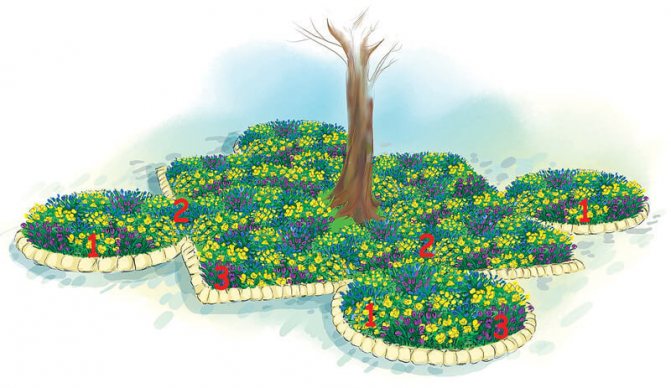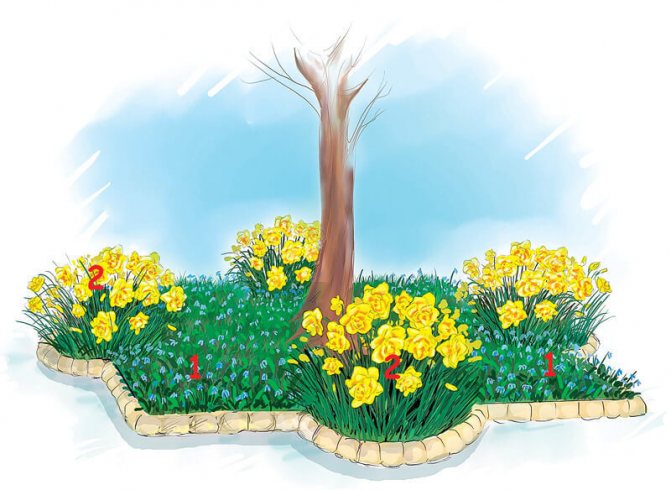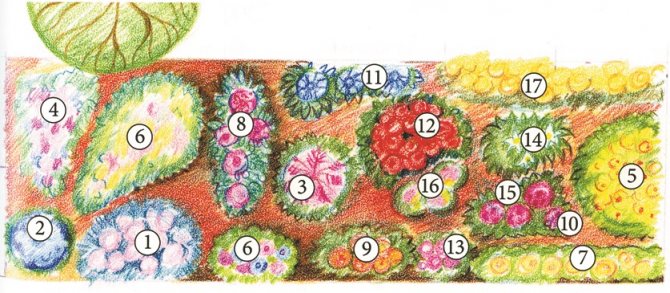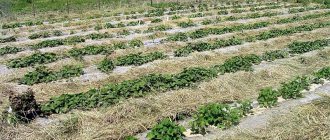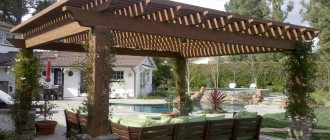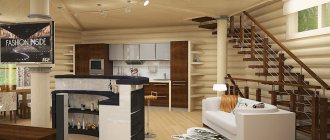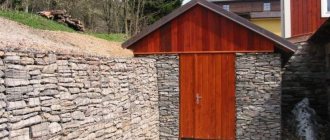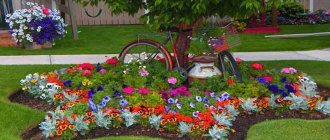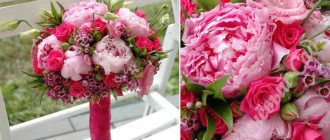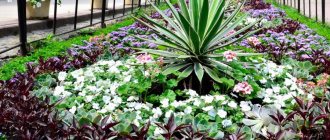The relevance of a flower bed around a tree
A flower bed around a tree can be relevant in several cases. First of all, such arrangement of a flower garden will be in demand with a lack of space and the need to use every opportunity in order to decorate the space with fragrant flowers. For such a planting, you can use any trees, including fruit crops in a traditional Russian garden. The choice of a tree is made taking into account how a particular species tolerates loosening of the soil in the immediate vicinity of the root system.
According to the experience of the designers, it happens that the garden is laid out in a forest area, where there are many mature trees that the owners want to preserve in order to preserve the feeling of the house being integrated into the natural landscape. In this case, a flower garden around the tree will allow you to decorate the site without destroying its atmosphere.
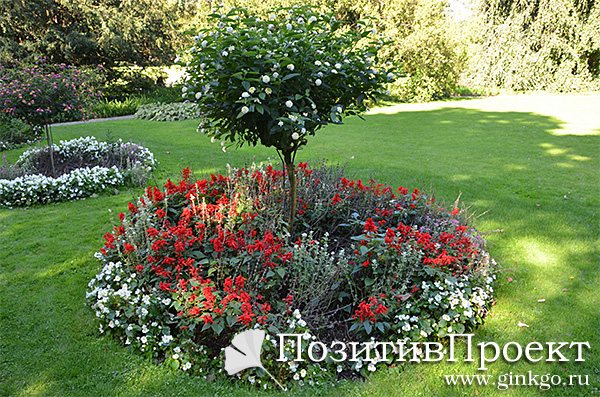
When arranging a garden in an ecological style, flower crops and all other plantings should be located in the same way as in a natural ecosystem. Flowerbeds around a tree are a very good option for a compositional solution. They should have arbitrary shapes that mimic natural shapes. Flowers should be chosen from local plants so that the whole object looks as organic as possible.
It is worth noting that flower gardens around trees are not very common in modern household plots, so this layout will be relevant for all lovers of original solutions.
Choosing a tree for a flower garden
Flower gardens in the area of tree-trunk circles require a special approach even at the stage of their planning. First of all, do not arrange such objects under immature seedlings. Newly planted trees are very vulnerable, their root system has not yet taken root, it is easy to damage it. Thus, adult and robust plants should be chosen for a flower garden around trees.
The fact that the tree casts a dense shadow also plays a role. So, under deciduous crops that strongly shade the surrounding area, it is necessary to plant only shade-loving flowers. Pine trees give an openwork shade and, it would seem, are great for building flower beds around them, but in old plants of this species, the root system is too close to the ground, and often even comes out to its surface. It is simply impossible to arrange a flower garden around such a tree, because powerful roots fill almost all the space under it.
There are trees that do not tolerate any additional soil interference. These crops include, for example, cedar or apple trees. For example, cedars grow well only if the soil under them is covered with their own needles: every year they form a fertile soil for themselves, and you cannot interfere in this process. It is enough to dig or loosen the ground under the cedar, and it will start to hurt. Apple trees can also be difficult to tolerate interference with the life of their root system. Usually, in the process of caring for these trees, the soil is dug up only by a third of a shovel, and this depth is not enough to make planting flowers.
When planning to diversify the landscape design of the site with a flower garden in the near-stem circle, you need to think about what appearance the object will have in a few years, because the trees grow and their outlines change.
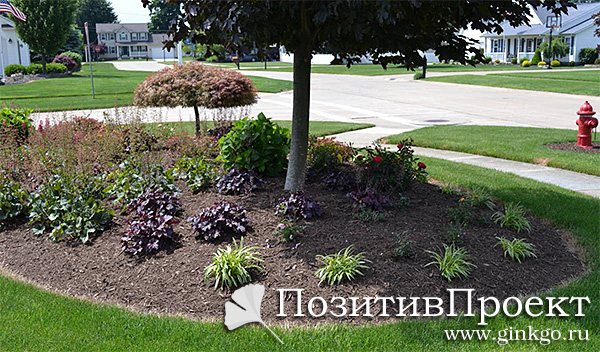

Stone decoration
The use of small pebbles or gravel to decorate tree trunks is especially popular with summer residents who cannot devote much time to their garden. These "helpers" are capable of:
- retain moisture;
- protect the roots from hot sunlight and severe frost;
- prevent weeds from growing;
- keep out pests.
This decor of the trunk circle frees the gardener from weeding, loosening and digging up the earth. Stones are a natural material that is durable, does not scatter from gusts of wind and looks spectacular.
Planting plants and features of caring for them
According to the designers, since the flowers and the tree from this moment will live side by side and share all resources with each other, they must have the same requirements for watering, soil characteristics and temperature conditions.
The actual planting of flowers is carried out in several stages:
- the soil under the tree is cleared of weeds and debris;
- the top layer of the soil is very carefully removed;
- if there are too many roots on the surface, then some of them can be chopped off, but not more than 10%, while the crown will also have to be cut proportionally;
- in large trees, it is usually impossible to free the entire area of the trunk circle, for planting plants here, depressions are only made in different places;
- new fertile soil is introduced into the formed depressions in the near-stem circle, and the area of the future flower bed as a whole can be slightly (no more than 10 cm) raised above the general level;
- after thorough watering, plants are planted and watered again;
- if the plants are planted in separate islands, then the space between them can be filled with mulch for decorative purposes.
Flowers planted under trees require more frequent watering. They also need more fertilizers. This is due to the fact that most of the resources from the soil in this place will be taken by the tree, and only the remnants will get the flowers.
All work related to the care of such a flower bed must be carried out very carefully, since when watering, weeding or loosening, there is a possibility of damaging the roots of the tree.
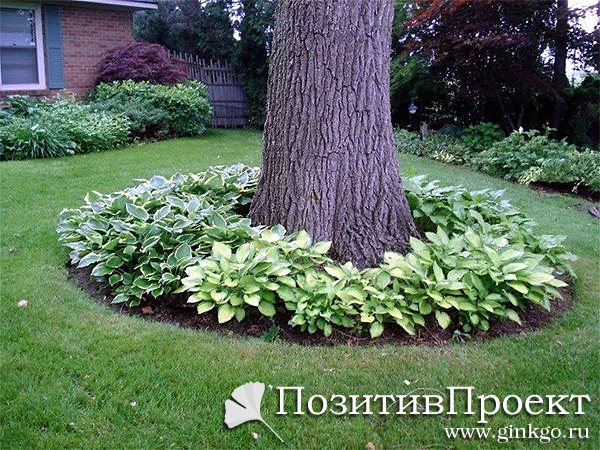

"Flowerpot" from the vine - non-standard approach
Instead of an ordinary flower bed under a tree, you can organize a raised flower bed in a "flowerpot" of vines. This design repeats with its outlines the near-trunk circle and resembles a large donut with a tree in the center.
In order to build such a beauty, pegs should be driven in two rows around the trunk. It turns out two circles - a larger and a smaller diameter. A vine is woven between the pegs, as in the construction of a fence-wattle. Please note that the "fences" should turn out to be dense, without gaps, since soil will subsequently be poured between them.
If it was not possible to observe the required density and the walls are pierced with many cracks, it is recommended to cover the "flowerpot" from the inside with a film so that the soil cannot spill out during the wind or wash out with rain streams. Now there is only one thing left to do - pour soil inside the improvised container and plant the plants. If the tree creates an openwork shade, then you can use lawn grass for landscaping. Otherwise, the species that we considered in the previous block of the article, when we chose plants for a flower garden under a tree, are suitable.
Design solutions for flower beds in near-stem circles
For a flower garden, a suitable tree is chosen in different parts of the garden: a single tree on the lawn, one of the trees in the orchard, a tree in the corner of the garden, etc. If in free space the flower beds will have the shape of a circle, an oval or their incorrect interpretations, then a semicircular or triangular flower garden can be made near the fence or in the corner.
The shape of the flower beds depends on the overall style of the site. In a regular garden, flower beds should be equipped with regular geometric shapes.The most natural round options look around a tree located exactly in the center of the flower garden. The rest of the parameters of the flower bed also need to be brought in line with linear solutions: the soil must be even, flowers can be planted in neat circles, even segments, or the entire near-stem circle can be filled with monoculture. Such an object will fit well into the landscape design of an open area, for example, it will effectively decorate a wide, evenly trimmed lawn.
Flower beds with asymmetrical outlines are suitable for landscape or ecological style. In this case, planting monocultures will be inappropriate, it is better to create an unobtrusive variety, as is usually the case in the wild. The flower bed should be of different tiers and combine flowers of different heights. In this case, tall plants will be closer to the center of the circle, and low and creeping ones will be located along the outer edge.
In a regular garden, a border around a flower bed is more common than in a landscape style garden. In any case, it becomes the most important decorative element. You can lay it out of bricks, natural stone, wooden chocks, tiles, you can weave it like a wattle fence or a basket, you can equip a stationary structure of cement and decorate it with smalt, mosaic or even broken porcelain.
The absence of a border creates the feeling of a smooth transition of flower plantings into the lawn. But you can also separate these elements with a scattering of pebbles or rubble. Pebbles and small stones are also filled in empty areas on the flowerbed itself. As a result, according to the experience of landscape designers, using a combination of colors, decorative green crops, stones and mulch, you can create a unique pattern that will make your flower bed a real work of art.
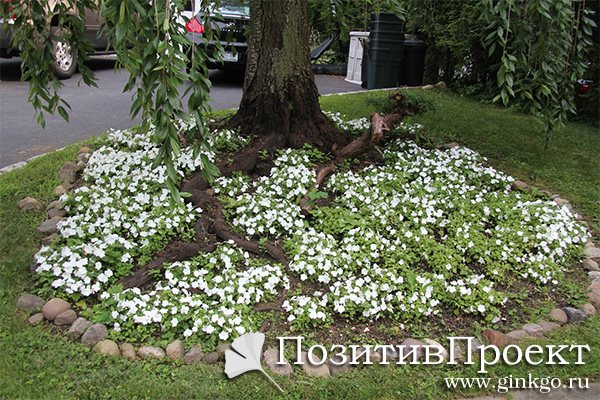

Mulching
In regions where rains are rare, but frosts are not, summer residents use dry manure, straw, peat or leaves with reeds in the form of mulch. There are reasons for this:
- it is a natural fertilizer that is dug up in the spring and gives the roots additional nutrition;
- this mulch warms the soil;
- retains moisture well.
It is important to know: such mulching should be done not only 10-15 cm from the trunk, as many gardeners do, but along the entire near-trunk circle.
However, in warmer regions, an increasing number of summer residents prefer not only to mulch the tree trunk circle of fruit trees, but also to decorate it. Pine cones, for example, are great for this. They look beautiful, keep heat well, let and retain moisture, are not blown away by the wind and do not give a chance for weeds to germinate through such a barrier.
In any case, the choice of which natural material to use for mulching remains with the summer resident, based on weather conditions and the needs of the tree itself.
Choice of colors
All plants that you choose to plant under a tree should be more or less shade-loving. Among such crops, in the first place are dwarf varieties of conifers, bulbous and annuals. There are very few shade-loving perennials. But with partial darkening, it is quite possible to use hosta, anemone, primrose, periwinkle and ivy.
A flower bed can be designed for a peak of decorativeness in any one period or for continuous flowering. For example, shade-loving lilies of the valley grow in the wild in dark spruce forests. Their garden counterparts bloom magnificently in May, and at other times they delight the eye with dense deciduous shoots, which are no less decorative. For those who like to see the most elegant flower beds, you can compose a composition of several types of plants, the flowering of which occurs in different seasons.
If you choose the right plants for a flower bed around a tree, then you can give this object very functional properties. So, many pests of fruit trees do not tolerate certain flowers.Blood aphids and apple honeydew do not like the neighborhood with nasturtium, nematodes cannot stand the smell of marigolds and chamomile, and if you plant lilies of the valley around stone fruit trees, then fruit rot will not be terrible for cherries and plums.
How to mulch trees with sawdust (video)
The most optimal crops for creating a low bosquette can be:
- barberry Thunberg;
- common barberry;
- common privet;
- hawthorn single-footed;
- felt cherry;
- steppe cherry;
- sand cherry;
- the cotoneaster is brilliant;
- spirea;
- blackthorn;
- viburnum vesicle.
Particularly popular is the western thuja, which is incredibly shade-tolerant and allows you to create dense hedges.

